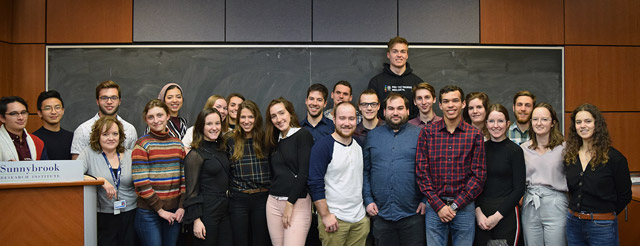An insightful look inside
The month of March can dredge up dreary hues of grey, enough slush on the side of the road to sour any morsel of a joyful mood and frustration over a wretched winter that has long overstayed its welcome. For a group of undergraduate students from Quebec, it just might mean that, but this year it also meant a fresh perspective on career opportunities.
On March 5, 2019, two dozen aspiring biomedical engineers from École Polytechnique de Montréal, running the gamut from first-years to seniors, were ushered through three Sunnybrook Research Institute (SRI) facilities: the device development lab, the machine shop and the focused ultrasound lab. All are situated in the Centre for Research in Image-Guided Therapeutics, which is unique in its scope and scale. The goal was to show the students what an institute outside of Quebec looks like, what kind of work is carried out in the department of medical biophysics at the University of Toronto and what the students’ futures could have in store if they pursue research.
Dr. Charles Cunningham, a senior scientist in Physical Sciences at SRI and the vice-chair of medical biophysics at U of T, put the day in motion. He spoke about the department, touched on the research of select graduate students and outlined the day’s itinerary.
Merle Casci, coordinator of SRI’s trainee centre and the organizer of the tour, then took the reins. She split the students into two groups, and off they went.
Taking the students through the device development lab on the seventh floor of Sunnybrook’s main building was Aaron Boyes, a research technician. He described some of the equipment, including the DISCO DAD3240 high-precision dicing saw, which cuts fine-scale layers for miniature ultrasound probes. Researchers are using these probes for imaging purposes, to see if they will help to detect, diagnose and treat diseases.
Michael Pozzobon, manager of the machine shop, guided the students around the space he oversees, just steps away from the device development lab. He spoke about some of the medical devices that are manufactured and tested on the premises, owing to the shop’s state-of-the-art equipment. One machine he shed light on is the waterjet cutter, which cuts any material, to form any shape, without heating or distorting the substance. The novel final products the machine produces become parts of tools used by SRI’s researchers, for example, components to use in focused ultrasound surgery.
The machine shop was what Antoine Boudreau-Alexandre, a third-year student in the program who reached out to arrange the visit, later recalled as a highlight. “I was impressed,” he said. “I didn’t think it would have such big machines.”
Down the corridor and around the corner, Marc Santos, a PhD student in the lab of Dr. Kullervo Hynynen, director of Physical Sciences at SRI, steered the procession through the focused ultrasound lab. Here, Santos shared some of the research being done to treat brain diseases. He discussed the blood-brain barrier, which prevents drugs from reaching the brain, and how Hynynen, who pioneered the technology, and other SRI scientists are using focused ultrasound to breach the barrier noninvasively for treatment delivery. He also talked about the equipment in the lab and the functions of the pieces.
Following the three stop-offs, the groups reconvened for refreshments. Stecia-Marie Fletcher and Rui Xu, PhD students in the lab of SRI scientist Dr. Meaghan O’Reilly, joined the crew for an informal Q&A. They offered insight into the department of medical biophysics, their perspectives on living in Toronto and how to balance the demands of a PhD with a social life. Casci also discussed the stipends and scholarship opportunities available to students who opt to pursue post-graduate studies.
Summing up the tour, fourth-year student Olivier Salvas said, “It was really good. We visited a few places in the hospital that we haven’t visited much in Montreal hospitals, like the machine shop and ultrasound lab. I think we’re more used to surface visits, so it’s been nice to go deep into the labs and to see the people working there.”
Asked whether the peek inside SRI clarified his plans post-graduation, Boudreau-Alexandre said, “It’s always very hard to decide what to do, but this does help, just to figure out what the possibilities are.”
As the students mulled over their experience, they also prepared for the day’s next two destinations: the CN Tower and the Distillery District.
In a nutshell
- Two dozen students from École Polytechnique de Montréal visited Sunnybrook Research Institute to learn about opportunities for aspiring biomedical engineers.
- The students visited research facilities that are unique in Canada, including the device development lab and focused ultrasound lab.
- The tour offered a peek into what post-graduate studies in the University of Toronto’s department of medical biophysics entails.







